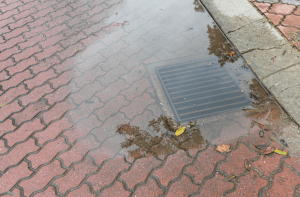Storm drains are important for managing rainwater in cities. However, when they break down, they can cause flooding, create dangerous conditions, and damage property.
Storm drain repair is important to prevent flooding and protect urban areas from water damage. When storm drains are clogged or damaged, they can’t properly manage rainwater. This can lead to property damage and create hazards for people. Regular maintenance and addressing issues such as blockages, pipe damage, and structural weaknesses are crucial.
Storm drain repair solutions include clearing out debris, repairing or replacing damaged pipes, and reinforcing drain structures. Keeping storm drains in good condition through frequent repairs helps ensure they function effectively.
In this guide, we will walk you through effective solutions for every common storm drain issue. Learn how to manage everything from simple blockages to more complicated issues to make sure storm drains work well.

Common Storm Drain Issues and Solutions
While storm drains are important for keeping our cities safe from water damage and flooding, they often face various problems that can affect how well they work.
The following are the common issues of storm drains and solutions for repair.
1. Clogged Storm Drains
Issue
Clogged storm drains are one of the most common problems in storm drains. They are often caused by leaves, dirt, debris, or litter building up inside the drain. This blockage prevents water from flowing freely, leading to flooding and standing water.
Solution:
Clogged storm drains can be fixed by removing visible debris by hand or with a hose to clear surface blockages. For deeper or more stubborn clogs, a plumbing snake can be used to effectively reach and remove the obstruction. In cases of severe blockages, professional hydro jetting services may be necessary to fully clear the drains and ensure they are functioning properly.
2. Cracked or Broken Pipes
Issue:
Cracks or breaks in storm drain pipes can occur due to age, shifting soil, or external damage. This issue can lead to water leakage, soil erosion, and reduced drainage efficiency.
Solution:
For cracked or broken pipes, repairs can be made by patching the affected areas with epoxy or lining them with a new resin-coated layer. If the damage is severe, replacing the damaged sections may be necessary. To prevent future issues, it is advisable to avoid planting trees near pipe lines and to conduct routine inspections to catch and address problems early.
3. Corrosion and Rust
Issue:
Corrosion and rust can significantly weaken storm drain pipes, especially those made of metal. Over time, rust eats away at the pipe’s material, causing leaks, blockages, and even structural failure.
Solution:
For corrosion and rust, pipes are inspected to identify the extent of the damage. If rust is present, applying a sealant can help slow the corrosion. In cases of severe damage, lining the pipes with a new layer or replacing the affected sections with PVC or HDPE pipes might be necessary. Regular inspections and the application of protective coatings can also prevent further rust and corrosion.
4. Collapsed Drain Pipes
Issue:
Collapsed drain pipes occur due to age, soil movement, or external pressure from heavy traffic or construction. A collapsed pipe disrupts water flow, leading to backups, flooding, and erosion.
Solution:
For collapsed drain pipes, sewer camera is used to assess the extent of the damage. Minor collapses can often be remedied with pipe lining, while more severe cases may require excavation and replacement of the damaged sections.
5. Tree Root Intrusion
Issue:
Tree roots naturally seek out water sources and can infiltrate storm drain pipes through small cracks or joints. Once inside, they can grow rapidly, causing blockages, leaks, and pipe damage.
Solution:
Tree root intrusion in pipes is addressed by first locating root entry points using a sewer camera. Minor invasions can be cleared with mechanical tools or chemicals. To prevent re-infiltration, consider lining the pipes. To avoid future issues, refrain from planting trees near pipe lines.
6. Structural Damage
Issue:
Structural damage to storm drains is repaired by using liners for small cracks or replacing severely damaged sections with durable materials like PVC. Regular inspections and reinforcing the surrounding soil are also crucial to prevent future damage.
Solution:
Repair with liners for small cracks or replace severely damaged sections. Use durable materials like PVC. Regular inspections and soil reinforcement prevent future damage.
7. Erosion and Sinkholes
Issue:
Erosion and sinkholes can happen near storm drains due to things like soil compaction, water runoff, and leaks underground. Over time, this can cause sinkholes to form around or above the pipes, which can be dangerous and damage the area.
Solution:
Erosion and sinkholes are fixed through a combination of identifying the root causes, stabilizing the soil, using erosion control blankets, and repairing any leaking pipes. For more severe issues, professional expertise is needed to manage and correct the underlying problems effectively.
Why is Storm Drain Repair Important?
Storm drain repair is important for maintaining proper drainage systems and preventing flooding in urban areas. When storm drains become clogged, cracked, or damaged, they can’t effectively channel rainwater away from streets and buildings.
This may lead to water accumulation and potential property damage. Additionally, malfunctioning storm drains can create safety hazards for pedestrians and motorists by causing slippery surfaces and road obstructions.
Regular checks, maintenance, and being proactive are key to keeping storm drains in good shape and protecting property and people.

